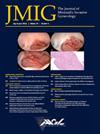Post-Marketing Experience With the Levalap™ 1.0: Improved Abdominal Access WHEN Using the Veress Needle During Laparoscopic Surgery
IF 3.5
2区 医学
Q1 OBSTETRICS & GYNECOLOGY
引用次数: 0
Abstract
Study Objective
The LevaLap™ 1.0 (Core Access Surgical Technologies, Atlanta, GA, USA) was designed to promote safer, more stable, and more predictable abdominal access when using the Veress needle for insufflation. Among other benefits, it increases the distance between the access site and retroperitoneal vessels by >5 cm. We report on the first post-marketing clinical study (PMCF) assessing experience with the use of the LevaLap™ 1.0 during gynecologic laparoscopic surgery.
Design
Prospective multicenter study.
Setting
Operating room.
Patients or Participants
Women ≥18 years old. Exclusion criteria: pregnancy, access site surgery in prior 10 days, abdominal hernia, contraindication to Veress needle or laparoscopy use, BMI >30 kg/m2, and inability/unwillingness to provide consent.
Interventions
Use of the LevaLap™ 1.0 to facilitate abdominal access when using the Veress needle for insufflation.
Measurements and Main Results
157 subjects were studied by 9 surgeons, each performing ≥5 cases (5-22 cases/surgeon); mean age: 43.6±14.4 yrs. and mean BMI: 24.8±3.8 kg/m2. Access site was 83.4% trans-umbilical, 15.3% peri-umbilical, 0.6% Palmer's point, and 0.6% other. Using the device, 96.8% (95% CI: 92.7%-99.0%, n=152/157) of patients’ access was successfully achieved at 1st attempt and 99.4% (95% CI: 96.5-100.0, n=156/157) within the first two attempts. One minor device-related AE was reported: a circular redness on the skin at the site of device application, resolving spontaneously the following morning. Surgeons noted easier access in 58%, increased confidence in 68.5%, increased access control in 66.9%, and increased access efficiency in 66.2% of cases.
Conclusion
The results of this PMCF study indicate that the use of the LevaLap™ 1.0 resulted in easier, greater control and greater efficiency during abdominal access using the Veress needle. In 96.8% of patients access was achieved at 1st attempt, and in 99.4% within the first two attempts. The use of the LevaLap™ 1.0 facilitates abdominal access when using the Veress needle for insufflation.
Levalap™ 1.0 上市后的经验:在腹腔镜手术中使用维雷斯针改善腹部入路WHEN
研究目的LevaLap™ 1.0(Core Access Surgical Technologies,美国佐治亚州亚特兰大市)的设计目的是在使用Veress针充气时促进更安全、更稳定和更可预测的腹腔入路。除其他优点外,它还能将入路部位与腹膜后血管之间的距离增加 5 厘米。我们报告了首个上市后临床研究(PMCF),评估了在妇科腹腔镜手术中使用 LevaLap™ 1.0 的经验。排除标准:妊娠、10 天前曾在入路部位进行过手术、腹部疝气、Veress 针或腹腔镜手术禁忌症、体重指数(BMI)30 kg/m2、无法/不愿提供同意书。测量和主要结果9名外科医生对157名受试者进行了研究,每名外科医生的手术量≥5例(5-22例/外科医生);平均年龄:43.6±14.4岁;平均体重指数:24.8±3.8 kg/m2。入路部位83.4%为经脐,15.3%为脐周,0.6%为帕尔默点,0.6%为其他。使用该装置后,96.8%(95% CI:92.7%-99.0%,n=152/157)的患者在第一次尝试时成功进入,99.4%(95% CI:96.5-100.0,n=156/157)的患者在前两次尝试中成功进入。报告了一起与设备相关的轻微不良反应:使用设备部位的皮肤出现环形发红,次日早晨自行消退。外科医生注意到 58% 的患者更容易进入,68.5% 的患者增加了信心,66.9% 的患者提高了进入控制,66.2% 的病例提高了进入效率。96.8%的患者在第一次尝试时就能进入腹腔,99.4%的患者在前两次尝试中就能进入腹腔。使用 LevaLap™ 1.0 可以在使用韦瑞斯针充气时更方便地进入腹腔。
本文章由计算机程序翻译,如有差异,请以英文原文为准。
求助全文
约1分钟内获得全文
求助全文
来源期刊
CiteScore
5.00
自引率
7.30%
发文量
272
审稿时长
37 days
期刊介绍:
The Journal of Minimally Invasive Gynecology, formerly titled The Journal of the American Association of Gynecologic Laparoscopists, is an international clinical forum for the exchange and dissemination of ideas, findings and techniques relevant to gynecologic endoscopy and other minimally invasive procedures. The Journal, which presents research, clinical opinions and case reports from the brightest minds in gynecologic surgery, is an authoritative source informing practicing physicians of the latest, cutting-edge developments occurring in this emerging field.

 求助内容:
求助内容: 应助结果提醒方式:
应助结果提醒方式:


